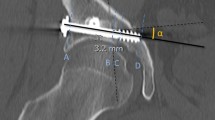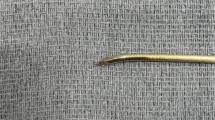Abstract
Background
Navigation assisted minimally invasive percutaneous screw fixation (MIS) for pelvi-acetabular fracture was recently advocated.
Methods
We report 38 consecutive cases of pelvi-acetabular fractures treated with 3D navigation-guided MIS from 2015 to 2016. Ohe hundred and forty-three screws were inserted (59 sacroiliac, 45 retrograde anterior column, 34 supra-acetabular, three antegrade posterior-column and two subcristal). Navigation planning was mainly performed pre-operatively.
Results
The mean operative blood loss and time was 179 ml and 141 mins, respectively. The distance (deviation) between the planned and executed screw entry and tip measured by the navigation computer were 1.91 and 1.94 mm, respectively. There were no immediate or early surgical complications. Patients were followed for at least 6 month; 79% had fracture healing at 4.3 months on average, and 53% walked unaided by the six month follow-up. The average visual analogue scale for pain was 2.69.
Conclusion
We believe 3D navigation-guided MIS is a safe and effective surgical alternative in most pelvi-acetabular fractures.





Similar content being viewed by others
References
Zwingmann J, Konrad G, Mehlhorn AT et al (2010) Percutaneous iliosacral screw insertion: malpositioning and revision rate of screws with regards to application technique (navigated vs. conventional). J Trauma 69:1501–1506
Gras F, Marintschev I, Wilharm A, Klos K, Muckley T, Hofmann GO (2010) 2D-fluoroscopic navigated percutaneous screw fixation of pelvic ring injuries— a case series. BMC Musculoskelet Disord 11:153
James MLW, Sam B, Jielin Y et al (2015) Fluoroscopically assisted computer navigation enables accurate percutaneous screw placement for pelvic and acetabular fracture fixation. Injury, Int J Care Injured 46:1064–1068
Behrendt D, Mütze M, Steinke H, Koestler M, Josten C, Böhme J (2012) Evaluation of 2D and 3D navigation for iliosacral screw fixation. Int J CARS 7:249–255
Amir M, David K, Christian K et al (2014) Three-Dimensional Navigation Is More Accurate than Two-Dimensional Navigation or Conventional Fluoroscopy for Percutaneous Sacroiliac Screw Fixation in the Dysmorphic Sacrum: A Randomized Multicenter Study. J Orthop Trauma 28:707–710
Ip KC, Lee KB (2014) Standardised multidisciplinary protocol for haemodynamically unstable pelvic fractures. J Orthop Surg 22(2):177–180
Cheng M, Cheung MT, Lee KY, Lee KB et al (2015) Improvement in institutional protocols leads to decreased mortality in patients with haemodynamically unstable pelvic fractures. Emerg Med J 32(3):214–220. https://doi.org/10.1136/emermed-2012-202009
Lau J, Chui KH, Ip KC, Lee KB et al (2016) Improved Survival with a Standardized Multidisciplinary 3-in-1 Pelvic Damage Control Protocol for Hemodynamically Unstable Pelvic Fracture. J Emerg Trauma Care 1:1
Tai DKC et al (2011) Retroperitoneal Pelvic Packing in the Management of Hemodynamically Unstable Pelvic Fractures: A Level I Trauma Center Experience. J Trauma 71(4):E79–E86. https://doi.org/10.1097/TA.0b013e31820cede0
Attias N, Lindsey RW, Starr AJ, Borer D, Bridges K, Hipp JA (2005) The use of a virtual three-dimensional model to evaluate the intraosseous space available for percutaneous screw fixation of acetabular fractures. J Bone Jt Surg Br 87:1520–1523
Chen KN, Wang G, Cao LG, Zhang MC (2009) Differences of percutaneous retrograde screw fixation of anterior column acetabular fractures between male and female: a study of 164 virtual three- dimensional models. Injury 40:1067–1072
Feng XR, Fang JT, Lin C et al (2015) Axial perspective to find the largest intraosseous space available for percutaneous screw fixation of fractures of the acetabular anterior column. Int J CARS 10:1347–1353. https://doi.org/10.1007/s11548-015-1149-6
Gardner MJ, Morshed S, Nork SE et al (2010) Quantification of the upper and second sacral segment safe zones in normal and dysmorphic sacra. J Orthop Trauma 24:622–629
Templeman D, Schmidt A, Freese J et al (1996) Proximity of iliosacral screws to neurovascular structures after internal fixation. Clin Orthop Relat Res:194–198
Chen H, Tang P, Yao Y, She F, Wang Y (2015) Anatomical study of anterior column screw tunnels through virtual three-dimensional models of the pelvis. Eur J Orthop Surg Traumatol 25:105–110
Gras F et al (2012) Screw- versus plate-fixation strength of acetabular anterior column fractures: A biomechanical study. J Trauma Acute Care Surg 72:6. https://doi.org/10.1097/TA.0b013e3182463b45
Kraemer W, Hearn T, Tile M, Powell J (1994) The effect of thread length and location on extraction strengths of iliosacral lag screws. Injury 25:5Y9
Müller F, Füchtmeier B (2013) Percutaneous cement-augmented screw fixation of bilateral osteoporotic sacral fracture. Unfallchirurg 116(10):950–954. https://doi.org/10.1007/s00113-013-2387-0
Arand M, Kinzl L, Gebhard F (2004) Computer-guidance in percutaneous screw stabilization of the iliosacral joint. Clin Orthop Relat Res 422:201–207
Dirhold BM et al (2012) Current state of computer-assisted trauma surgery. Curr Rev Musculoskelet Med 5:184–191. https://doi.org/10.1007/s12178-012-9133-z
Grossterlinden L, Nuechtern J, Begemann PG et al (2011) Computer-assisted surgery and intraoperative three-dimensional imaging for screw placement in different pelvic regions. J Trauma 71:926–932
Konrad G, Zwingmann J, Kotter E, Sudkamp N, Oberst M (2010) Variability of the screw position after 3D-navigated sacroiliac screw fixation. Influence of the surgeon’s experience with the navigation technique. Unfallchirurg 113(1):29–35
Wang H, Wang F, Leong APY et al (2016) International Orthopaedics (SICOT) 40:1941. https://doi.org/10.1007/s00264-015-3028-8
Manganaro MS et al (2017) Creating Three-dimensional Printed Models of Acetabular Fractures for Use as Educational Tools. Radiographics 37:871–880
Leung KS, Tang N, Cheung WH, Ng WK (2008) Robotic arm in orthopaedic trauma surgery–early clinical experience and a review. Punjab J Orthop 10:5–9
Author information
Authors and Affiliations
Corresponding author
Ethics declarations
Conflict of interest
The authors declare no conflict of interest.
Electronic supplementary material
ESM 1
(PDF 3321 kb)
Rights and permissions
About this article
Cite this article
Chui, K.H., Chan, C.C.D., Ip, K.C. et al. Three-dimensional navigation-guided percutaneous screw fixation for nondisplaced and displaced pelvi-acetabular fractures in a major trauma centre. International Orthopaedics (SICOT) 42, 1387–1395 (2018). https://doi.org/10.1007/s00264-017-3659-z
Received:
Accepted:
Published:
Issue Date:
DOI: https://doi.org/10.1007/s00264-017-3659-z




